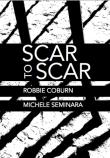AustLit
The material on this page is available to AustLit subscribers. If you are a subscriber or are from a subscribing organisation, please log in to gain full access. To explore options for subscribing to this unique teaching, research, and publishing resource for Australian culture and storytelling, please contact us or find out more.
Latest Issues
AbstractHistoryArchive Description
'Scar to Scar is an evocative collaborative work in which poet Michele Seminara responds to the work of Robbie Coburn, finding new texts within his poems. Initially begun as a means of extracting light from what were often troubling topics, the poems use the same language to create entirely different 'counter' pictures. The collaboration soon developed into a way of exploring the connection between the two poets, as well as their individual and shared connections to language and expression.' (Publication Summary)
Publication Details of Only Known VersionEarliest 2 Known Versions of
Works about this Work
-
Collaborations! Mark Roberts Reviews ‘The Silences’ by Amanda Anastasi and Robbie Coburn & ‘Scar to Scar’ by Robbie Coburn and Michele Seminara
2017
single work
review
essay
— Appears in: Rochford Street Review , January – March no. 21 2017; 'I have been thinking a lot about poets working together on projects recently. I suspect that this has grown from reading translations and feeling, at times, slightly frustrated by the idea that there is an extra layer between my reading and the original poem. I noticed this particularly a few months back when reading the translations by Stephen Kessler of the Spanish poet Luis Cernuda. The translations were presented next to the original Spanish and, while I couldn’t read the poems in the Spanish, it was clear that Kessler had taken some major liberties with the structure of the poems, moving words from line to line and even from stanza to stanza. Armed with a Spanish English dictionary and a good online translator I began to create literal translations from the Spanish which I then reworked myself into versions I preferred. This, I realised, was a great example of how a good translator must do more than simply translate between languages – give the same poem to three different translators and chances are you will come up with three different poems.' (Introduction)
-
Collaborations! Mark Roberts Reviews ‘The Silences’ by Amanda Anastasi and Robbie Coburn & ‘Scar to Scar’ by Robbie Coburn and Michele Seminara
2017
single work
review
essay
— Appears in: Rochford Street Review , January – March no. 21 2017; 'I have been thinking a lot about poets working together on projects recently. I suspect that this has grown from reading translations and feeling, at times, slightly frustrated by the idea that there is an extra layer between my reading and the original poem. I noticed this particularly a few months back when reading the translations by Stephen Kessler of the Spanish poet Luis Cernuda. The translations were presented next to the original Spanish and, while I couldn’t read the poems in the Spanish, it was clear that Kessler had taken some major liberties with the structure of the poems, moving words from line to line and even from stanza to stanza. Armed with a Spanish English dictionary and a good online translator I began to create literal translations from the Spanish which I then reworked myself into versions I preferred. This, I realised, was a great example of how a good translator must do more than simply translate between languages – give the same poem to three different translators and chances are you will come up with three different poems.' (Introduction)
Last amended 20 Jan 2017 10:20:27




